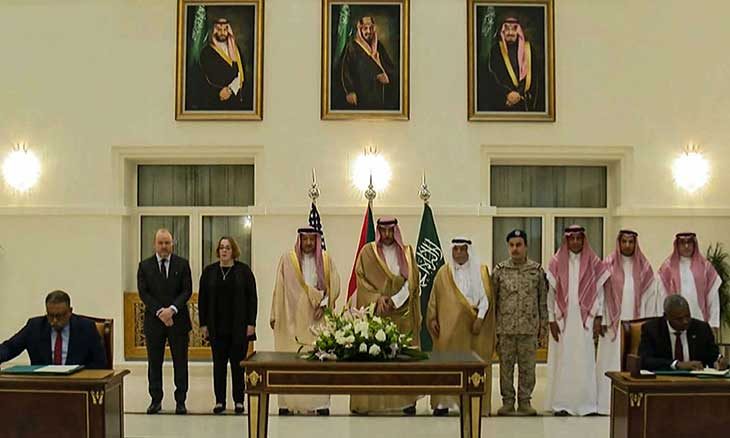
Eight Months into the War, No End to the Sudanese Crisis Except Through Dialogue
Mariam Abasher
The war in Sudan has entered its eighth month, and the battles continue to intensify, expanding between the army and the Rapid Support Forces. Despite the efforts of international mediators to reduce tension and pave the way for international and regional organizations to provide humanitarian assistance and open safe routes for relief to the affected, the situation remains unresolved, especially for those besieged within the capital and the displaced to other states.
As the conflict in Sudan enters its eighth month, a discourse of hatred and incitement persists despite the loss of thousands of innocent lives and the injuries and disappearances of many more.
Sudans conflict is entering its eighth month, and Jeddahs platform has become the closest, luckiest, and most trusted hope for Sudanese people, including the conflicting parties, to settle disputes and continue the initiated dialogue with greater seriousness.
As Sudans conflict enters its eighth month, significant regional and international developments have occurred. In recent days, there have been diplomatic visits, including one by the armys leader, Abdel Fattah al-Burhan, to both Kenya and Ethiopia. Kenya had previously questioned her presidency of the IGAD Quartet and described her position at that time as ambiguous. Another visit was made to Ethiopia, where Prime Minister Abiy Ahmed stated that Sudan is experiencing a constitutional vacuum, implying non-recognition of the current government.
According to observers, al-Burhans visits to both countries, along with sideline meetings with the African Unions chairperson, Moussa Faki, and other officials, have thawed tensions and given strong impetus to the Jeddah platform.
Relying on the Jeddah platform as an exit to save what remains of the country is supported by the political forces rejecting the war, seeing in dialogue the most effective tool to settle differences between the parties.
At the forefront of these forces is the Forces for Freedom and Change Alliance (Central Council). In recent days, an important meeting took place between representatives of the Communication and External Relations Committee and a delegation from the European Union, including the Swedish envoy to Sudan and ambassadors from Germany, France, Spain, the Netherlands, Poland, and the EU representative in Cairo.
During the meeting, the European Union emphasized its interest in what is happening in Sudan. The discussion focused on ways to end the conflict, address the humanitarian disaster, achieve stability, resume the democratic transition, and coordinate international and regional efforts through a unified negotiating platform.
The movements of the Central Council, which has just completed the formulation of a roadmap to end the conflict and achieve a comprehensive political settlement, have prompted a request to meet with leaders of the army and the Rapid Support Forces for consultation.
In the context of accelerated international and regional steps to find a solution to the war in Sudan, the Secretary-General of the United Nations, Antonio Guterres, appointed the former Algerian Foreign Minister Ramadan Al-Amamra as his personal envoy to Sudan. This move reflects the UNs focus on the situation in Sudan, following the horrific violations and humanitarian crisis, through Al-Amamras direct and close supervision of the situation.
Ambassador and diplomatic expert Jamal Mohamed Ibrahim sees dialogue as the only way out of the crisis, describing the conflicting parties actions as targeting infrastructure such as bridges, airports, communication institutions, and sovereign buildings like the presidency and ministries. He emphasizes that the international community should be aware that the war, escalating internally, involves external parties with aspirations and purposes that go beyond targeting Sudanese individuals alone. Instead, it extends to destroying their way of life and eradicating the past existence of national institutions and structures, ultimately aiming to end the existence of the Sudanese state on the ground.

